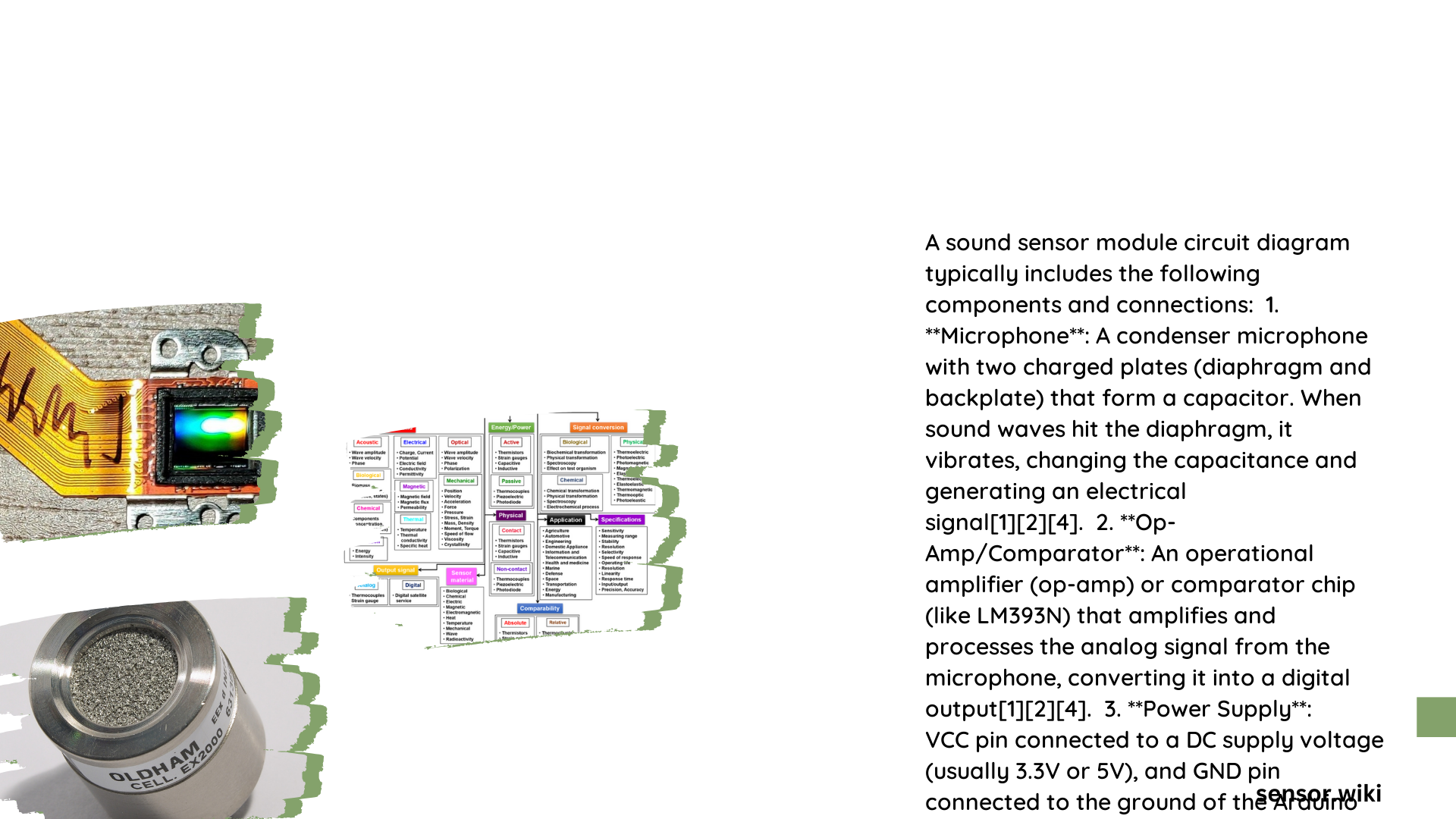A sound sensor module circuit diagram typically consists of a microphone, amplifier, comparator, and various supporting components. These modules are designed to detect sound levels and convert them into electrical signals for processing by microcontrollers. The circuit includes power supply connections, digital and analog outputs, and often features adjustable sensitivity. Understanding the circuit diagram is crucial for proper integration and troubleshooting in various audio detection applications.
What are the Key Components of a Sound Sensor Module?
A typical sound sensor module, such as the KY-038, includes the following components:
- Condenser Microphone
- Operational Amplifier (Op-Amp)
- Comparator
- Potentiometer
- LEDs (Power and Signal)
- Resistors
- Capacitors
- Transistors
Component Specifications
| Component | Typical Specification |
|---|---|
| Microphone | Electret condenser type |
| Op-Amp | LM393N or LM358 |
| Resistors | 10KΩ, 100KΩ, 20KΩ |
| Capacitors | 120nF |
| Transistors | 2N4401 (NPN), 2N4403 (PNP) |
| Potentiometer | 100KΩ or 20KΩ |
| Diode | IN4001 |
How is the Circuit Connected?

The sound sensor module circuit is connected as follows:
- The microphone is connected to the input of the Op-Amp.
- The Op-Amp amplifies the signal and feeds it to the comparator.
- The comparator sets a threshold using the potentiometer and outputs a digital signal.
- The power LED is connected between VCC and GND.
- The signal LED is connected to the output of the comparator.
- Resistors and capacitors are used for biasing, voltage division, and filtering.
- Transistors may be used to drive relays or LEDs based on the digital output.
What are the Pin Configurations of a Sound Sensor Module?
A typical sound sensor module has the following pin configurations:
- VCC: Power supply pin (3.3V or 5V)
- GND: Ground pin
- DO (Digital Output): Provides a digital signal indicating sound detection
- AO (Analog Output): Provides an analog signal representing sound intensity
How to Connect a Sound Sensor Module to a Microcontroller?
To connect a sound sensor module to a microcontroller like Arduino UNO:
- Connect VCC to the 5V pin on the Arduino.
- Connect GND to the GND pin on the Arduino.
- Connect DO to a digital input pin (e.g., pin 2) on the Arduino.
- Connect AO to an analog input pin (e.g., A0) on the Arduino if using the analog output.
What are the Best Practices for Wiring a Sound Sensor Module?
When wiring a sound sensor module:
- Use 22 AWG or 24 AWG wires for connections.
- Keep wire lengths as short as possible to minimize noise.
- Apply proper soldering techniques:
- Use a temperature-controlled soldering iron.
- Apply a small amount of solder flux to joints.
- Ensure clean and secure connections.
- Use a breadboard or PCB for prototyping.
What are Common Applications of Sound Sensor Modules?
Sound sensor modules have various applications:
- Sound-activated LEDs
- Music visualizers
- Alarm systems
- Automated lighting
- Environmental noise monitoring
How to Troubleshoot Common Issues with Sound Sensor Modules?
Here are some troubleshooting tips for common issues:
- LED not responding:
- Check LED polarity
-
Verify all connections
-
No reaction to sound:
- Adjust sensitivity using the potentiometer
-
Check DO pin connections
-
Intermittent signals:
- Use shorter wires
- Add noise filtering components if necessary
What Environmental Factors Affect Sound Sensor Module Performance?
Sound sensor modules are affected by:
- Temperature: Typically operate between 0°C to 50°C
- Humidity: Perform best in moderate humidity levels
- Noise interference: Requires proper shielding and filtering
By understanding the sound sensor module circuit diagram and its components, you can effectively integrate these sensors into your projects and troubleshoot any issues that may arise.
References:
1. https://www.watelectronics.com/sound-sensor/
2. https://circuitdigest.com/microcontroller-projects/interfacing-sound-sensor-with-arduino
3. https://www.build-electronic-circuits.com/arduino-sound-sensor/
